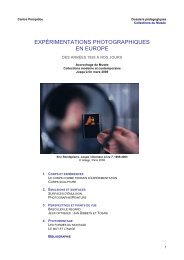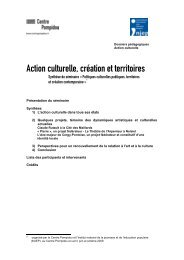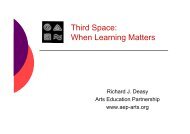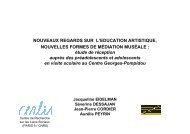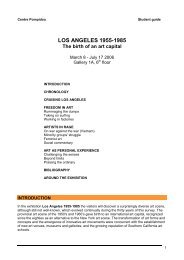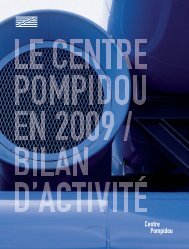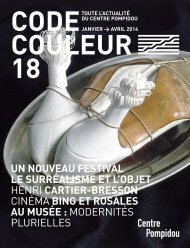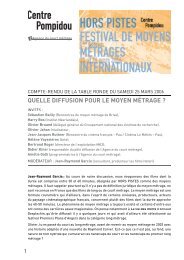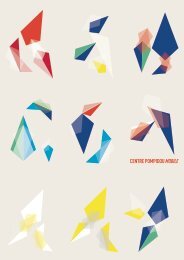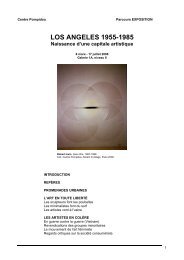to download the PowerPoint presentation - Centre Pompidou
to download the PowerPoint presentation - Centre Pompidou
to download the PowerPoint presentation - Centre Pompidou
You also want an ePaper? Increase the reach of your titles
YUMPU automatically turns print PDFs into web optimized ePapers that Google loves.
Evaluating <strong>the</strong> Impact of Arts and Cultural<br />
Education on Children and Young People:<br />
A European and International Research<br />
Symposium<br />
January 10 -12, 2007 Paris, France<br />
MOVING TOWARD A CULTURE OF EVIDENCE:<br />
Documentation and Action Research<br />
In <strong>the</strong> Practice of Arts Partnerships<br />
Part I:<br />
Background on CAPE (Chicago Arts Partnerships in Education)<br />
as a case study
Moving Toward a Culture<br />
of Evidence:<br />
Documentation and<br />
Action Research in <strong>the</strong><br />
Practice of Arts<br />
Partnerships
Gail Burnaford, Ph.D.<br />
Arnold Aprill, Executive Direc<strong>to</strong>r, Chicago<br />
Arts Partnerships in Education<br />
burnafor@fau.edu<br />
Florida Atlantic University<br />
aprill@capeweb.org<br />
CAPE
Chicago Arts Partnerships in Education (CAPE)<br />
What is CAPE?
A network of 100 schools (ages 5 years <strong>to</strong> 18 years) and<br />
artists and arts organizations working in long term<br />
partnerships dedicated <strong>to</strong> improving public education by<br />
exploring <strong>to</strong>ge<strong>the</strong>r <strong>the</strong> roles of <strong>the</strong> arts in teaching and<br />
learning
moving from<br />
Access <strong>to</strong> <strong>the</strong> Arts<br />
<strong>to</strong><br />
Active Democratic Participation in <strong>the</strong> Arts
moving from<br />
false dicho<strong>to</strong>mies (i.e.: intrinsic vs. extrinsic,<br />
integrated vs. direct instruction)<br />
<strong>to</strong><br />
syn<strong>the</strong>sizing frameworks (i.e.: interdisciplinary<br />
thinking, exploring student<br />
cognition)
moving from<br />
research on<br />
<strong>to</strong><br />
research with
A Community of Reflective Practice
A professional development network partnering<br />
with Chicago Public Schools
Working with teachers, artists, and principals
Committed <strong>to</strong> Student Centered Instruction
Includes contemporary arts practice
Integrated with <strong>the</strong> academic curriculum
Inquiry based
Community based
Preparing students for success in an information<br />
economy
Involving teachers in <strong>the</strong>ir own growth
Committed <strong>to</strong> innovative approaches <strong>to</strong> arts<br />
education research
Committed <strong>to</strong> writing and publishing about <strong>the</strong> work
Innovative exhibitions and installations
Interested in how students and teachers<br />
and artists think about <strong>the</strong>ir work in <strong>the</strong> arts
Networked <strong>to</strong> cutting edge colleagues nationally…
…and internationally
Committed <strong>to</strong> joyful and equitable education for all learners
Evaluating <strong>the</strong> Impact of Arts and Cultural<br />
Education on Children and Young People:<br />
A European and International Research<br />
Symposium<br />
January 10 -12, 2007 Paris, France<br />
MOVING TOWARD A CULTURE OF EVIDENCE:<br />
Documentation and Action Research<br />
In <strong>the</strong> Practice of Arts Partnerships<br />
Part II: methods and findings
Gail Burnaford, Ph.D.<br />
Arnold Aprill, Executive Direc<strong>to</strong>r, Chicago<br />
Arts Partnerships in Education<br />
burnafor@fau.edu<br />
Florida Atlantic University<br />
aprill@capeweb.org<br />
CAPE
Talking Point #1<br />
Layered Research and<br />
Evaluation that engages<br />
practitioners
Action research as part of a layered<br />
research plan with external<br />
researchers and evalua<strong>to</strong>rs<br />
Collective and collaborative<br />
development of instrumentation and<br />
research methodologies
Data collec<strong>to</strong>rs inside and outside of <strong>the</strong><br />
work<br />
Instrumentation used by different<br />
stakeholders and researchers<br />
Engagement of stakeholders in curriculum<br />
culminating events that are also research<br />
sharing events
Seeing research and<br />
evaluation as part of<br />
professional<br />
development of<br />
teachers, artists, and<br />
administra<strong>to</strong>rs
Talking Point #2<br />
Evaluation Questions<br />
that contribute <strong>to</strong> <strong>the</strong> field<br />
as well as <strong>to</strong> individual<br />
program capacity
Examples of evaluation questions<br />
that contribute <strong>to</strong> <strong>the</strong> field:<br />
How do music program professional<br />
development institutes and sessions impact<br />
teachers’ thinking and practice?<br />
What is <strong>the</strong> relationship between <strong>the</strong> strategies<br />
and instructional approaches used in <strong>the</strong><br />
Museum Education Program and <strong>the</strong> specific<br />
strategies and instructional approaches used<br />
by partner classroom teachers in <strong>the</strong> class<br />
literacy block?
How do arts programs create a teaching<br />
culture in a school?<br />
How does arts integrated instruction<br />
developed through cross-school<br />
school<br />
partnerships enhance student<br />
achievement in both <strong>the</strong> arts and in<br />
o<strong>the</strong>r academic content areas?
Talking Point #3<br />
Measurable Indica<strong>to</strong>rs<br />
That Inform <strong>the</strong> Field<br />
Evaluating Teaching<br />
Evaluating Student Engagement<br />
Evaluating Professional Development (not<br />
part of this paper)
Evaluating Teaching<br />
Current research says<br />
TEACHERS DO MATTER<br />
(Darling-Hammond &<br />
Bransford, , 2005)
Students who are assigned <strong>to</strong> several<br />
highly effective teachers in a row have<br />
significantly greater gains in achievement<br />
than those who are assigned <strong>to</strong> less<br />
effective teachers; fur<strong>the</strong>rmore, <strong>the</strong><br />
influence of each teacher has effects that<br />
spill over in<strong>to</strong> later years (Sanders and<br />
Rivers, 1996).
Consider…<br />
Student achievement seems <strong>to</strong> be<br />
higher when teachers have high<br />
verbal skills as well as strong<br />
knowledge of <strong>the</strong> content <strong>the</strong>y teach.<br />
(Ehrenberg and Brewer, 1995; Ballou<br />
and Podgursky, , 1997)
School change =<br />
instructional impact<br />
The literature often addresses <strong>the</strong><br />
challenge of bringing projects or<br />
innovations <strong>to</strong> scale. Often <strong>the</strong><br />
innovation barely scratches <strong>the</strong><br />
surface BECAUSE it does not reach<br />
in<strong>to</strong> <strong>the</strong> classroom in order <strong>to</strong><br />
influence instruction (Cuban, 1988,<br />
Elmore, 1996, Coburn, 2003).
Example:<br />
Standards for Effective Practice<br />
www.crede.org<br />
<br />
(Center for Research on Education, Diversity and Excellence)<br />
Investigate and collect data about<br />
teacher practices measured against<br />
Standards and relevant Indica<strong>to</strong>rs of<br />
Effective Pedagogy
Develop <strong>to</strong>ol for investigating<br />
teacher quality within arts programs<br />
<br />
Teachers and Students Working Toge<strong>the</strong>r<br />
Use instructional group activities in which students and teacher work <strong>to</strong>ge<strong>the</strong>r <strong>to</strong> create a product<br />
or idea.<br />
<br />
<br />
<br />
<br />
<br />
• Developing Language and Literacy Skills across all Curriculum<br />
Apply literacy strategies and develop language competence in all subject areas.<br />
• Connecting Lessons <strong>to</strong> Students' Lives<br />
Contextualize teaching and curriculum in students' existing experiences in home, community, and<br />
school.<br />
• Engaging Students with Challenging Lessons<br />
Maintain challenging standards for student performance; design activities a<br />
<strong>to</strong> advance<br />
understanding <strong>to</strong> more complex levels.<br />
• Emphasizing Dialogue over Lectures<br />
Instruct through teacher-student dialogue, especially academic, goal-directed, small-group<br />
conversations (known as instructional conversations), ra<strong>the</strong>r than n lecture.<br />
The Five Standards articulate both philosophical and pragmatic guidelines g<br />
for effective education.<br />
The standards students in K-16 K<br />
classrooms across subject matters, curricula, cultures and<br />
language groups.
Sample section from instrument:<br />
Standards + arts-specific specific indica<strong>to</strong>rs<br />
<br />
<br />
During <strong>the</strong> arts project or unit this year, , please report on <strong>the</strong> extent <strong>to</strong><br />
which <strong>the</strong>se activities occur:<br />
1: Rarely evident 2: Sometimes evident 3: Usually evident<br />
4: Always evident<br />
TEACHERS AND STUDENTS WORK TOGETHER DURING ARTS<br />
PROJECT.<br />
1 2 3 4 1. Students teach students.<br />
1 2 3 4 2. Students teach <strong>the</strong> teacher(s) or artist(s).<br />
1 2 3 4 3. Students plan and negotiate with each o<strong>the</strong>r.<br />
LANGUAGE AND LITERACY SKILLS ARE APPEAR ACROSS THE<br />
CURRICULUM DURING ARTS PROJECT.<br />
1 2 3 4 4. Students match movement and text.<br />
1 2 3 4 5. Students use pre and post writes.<br />
1 2 3 4 6. Students use arts vocabulary.
Evaluating Student Engagement<br />
Example:<br />
ADAPTED FROM NCREL<br />
STANDARDS FOR ENGAGEMENT<br />
Engaged Learning Inven<strong>to</strong>ry<br />
G. Burnaford 2005
SAMPLE SECTION<br />
<br />
<br />
<br />
<br />
Person completing survey: _________________<br />
Date: _______________<br />
Classroom & Grade Level: ___________________ Classroom teacher’s s name:<br />
_____________________<br />
Role (Teacher, principal, teaching artist, parent, staff member) ________________<br />
School: _____________________<br />
Research has shown that <strong>the</strong> elements noted below are strong indica<strong>to</strong>rs of ‘engaged learning.’<br />
Please respond <strong>to</strong> each item thoughtfully with respect <strong>to</strong> <strong>the</strong> specific day and time that you are<br />
observing and assessing. . Attach any documentation that may explain your responses.<br />
<br />
<br />
<br />
<br />
<br />
<br />
<br />
<br />
<br />
<br />
1. Vision of Learning<br />
Learner is involved in setting goals and choosing tasks<br />
0 = not in evidence 1 = seldom 2= sometimes 3= often 4=consistently/always<br />
Learner is actively developing reper<strong>to</strong>ire of personal learning strategiess<br />
0 = not in evidence 1 = seldom 2= sometimes 3= often 4=consistently/always<br />
Learner is not dependent on concrete rewards<br />
0 = not in evidence 1 = seldom 2= sometimes 3= often 4=consistently/always<br />
Learner is developing ideas in collaboration with o<strong>the</strong>rs<br />
0 = not in evidence 1 = seldom 2= sometimes 3= often 4=consistently/always<br />
Comments:
Three Talking Points<br />
Talking Point #1: Layered<br />
Research and Evaluation<br />
that engages<br />
practitioners
Talking Point #2<br />
Evaluation Questions<br />
that contribute <strong>to</strong> <strong>the</strong> field<br />
as well as <strong>to</strong> individual<br />
program capacity
Talking Point #3: Measurable<br />
Indica<strong>to</strong>rs that Inform <strong>the</strong> Field<br />
Evaluating Teaching<br />
Evaluating Student Engagement<br />
<br />
(Evaluating Professional Development)
Snapshot of Early Arts Literacies (SEAL)<br />
Assessing student aes<strong>the</strong>tic cognition<br />
• focused on learners’ aes<strong>the</strong>tic thinking processes<br />
• scored using a rubric measuring increasing complexity<br />
of student thinking
Question<br />
Level 1 Š No Relevant<br />
Response<br />
(Irrelevant response or<br />
silence; Answers, ĥNothing;<br />
You canÕt; I donÕt remember;<br />
I donÕt know,Ó Answer does<br />
not relate <strong>to</strong> question)<br />
Level 2 Š Single<br />
Dimensional<br />
(Generic statements,<br />
singular perspective, no<br />
elaboration, no detail,<br />
unspecific, unfocused,<br />
diffused, lists<br />
undifferentiated<br />
elements)<br />
Level 3 Š Multiple<br />
Single Dimensions<br />
(Occasional detail, some<br />
elaboration or specificity,<br />
some coordination of<br />
elements)<br />
Level 4 Š Coordination<br />
of Dimensions<br />
(Often provides elaborative,<br />
detailed, relational<br />
statements, including<br />
elements of interpersonal<br />
insight and purpose, artistic<br />
aes<strong>the</strong>tic, and/or his<strong>to</strong>rical<br />
references)<br />
Level 5 Š Systemic<br />
Understanding<br />
(Substantial detail,<br />
specificity, causal<br />
statements, compare<br />
and contrast, critical<br />
perspective, highly<br />
complex, multiple<br />
relationships)<br />
1. What is<br />
art?<br />
A word/statement that<br />
provides modest <strong>to</strong> no<br />
information or lists<br />
undifferentiated<br />
elements:<br />
Something you do<br />
Drawing<br />
When you make a<br />
collage<br />
Sound<br />
Playing different<br />
instruments<br />
Tap dancing<br />
Acting out a<br />
character<br />
in a play<br />
When you take a<br />
piece of paper and tear<br />
it up<br />
Lists and/or combines<br />
two or more clearly<br />
differentiated<br />
elements/ideas:<br />
Drawing, painting, or<br />
when you make a collage<br />
When you take a piece<br />
of paper, tear it up, and<br />
make it in<strong>to</strong> something<br />
Draw anything you<br />
Want <strong>to</strong> have fun, express<br />
yourself or design<br />
something<br />
Rhythm, melody, and<br />
lyrics<br />
Movement/Steps<br />
(includes demonstration<br />
and/or listing examples<br />
Something that has a<br />
plot, a main event, a<br />
conflict, and/or a setting<br />
Multiple single statements<br />
coordinated with a higher<br />
dimension that may be<br />
more abstract or<br />
intangible:<br />
Painting, coloring, and<br />
drawing things until <strong>the</strong>y<br />
look beautiful<br />
When you use your<br />
imagination <strong>to</strong> paint a<br />
picture, draw a sketch, or<br />
make a collage<br />
Putting <strong>to</strong>ge<strong>the</strong>r sounds <strong>to</strong><br />
express your feelings, tell a<br />
s<strong>to</strong>ry or make people happy<br />
Acting, reading a script,<br />
or when you take on <strong>the</strong><br />
personality of a character <strong>to</strong><br />
tell a s<strong>to</strong>ry<br />
Describes a relational<br />
statement in more<br />
detail, using contrast<br />
or providing an<br />
elaborative<br />
explanation:<br />
When you use your<br />
imagination instead of<br />
drawing <strong>the</strong> real thing<br />
like you may draw<br />
purple trees and give <strong>the</strong><br />
sun a smiley face even<br />
though thatÕsnot how it<br />
looks in real life<br />
Putting <strong>to</strong>ge<strong>the</strong>r<br />
many sounds <strong>to</strong> express<br />
your feelings or ideas,<br />
using rhythms, melody,<br />
and different<br />
instruments like a lively<br />
rhythm with a good<br />
melody played by a<br />
guitar might express<br />
your happiness
1. Observation<br />
Students engage in pre and post art<br />
activities which provide a chance <strong>to</strong><br />
observe student skill and<br />
understanding.
2. Questions<br />
Students answer a series of questions<br />
directed <strong>to</strong>ward <strong>the</strong>ir understanding of<br />
<strong>the</strong> art form <strong>the</strong>y are engaging.<br />
Examples: ”What is dance? Where do<br />
your ideas come from? How do you<br />
know when you are done?”
3. Response<br />
Students respond <strong>to</strong> a professional<br />
sample artwork. Example prompt:<br />
"What does this work express?"
4. Reflection<br />
Students reflect on <strong>the</strong>ir own work<br />
and <strong>the</strong> work of fellow students.
Data collection includes<br />
•videotapes and artifacts of students’<br />
pre and post art activities<br />
• artifacts of student work in progress<br />
• finished products<br />
• videotaped and written interviews
Pre Test<br />
Post Test
Artifacts from works in progress
Finished products
References<br />
Ballou, , D. & Podgursky, , M. (1997). Teacher pay and teacher<br />
quality. W.E. Upjohn Institute for Employment Research.<br />
Coburn, C.E. (2003). Rethinking scale: Moving beyond numbers <strong>to</strong> deep and<br />
lasting change. Educational Researcher, 32(6), 3-12. 3<br />
Cuban, L. (1988). Constancy and change in schools (1880s <strong>to</strong> <strong>the</strong> present). In P.<br />
Jackson (Ed.) Contributing <strong>to</strong> educational change. Berkeley, CA: McCutchan, , 85-<br />
105.<br />
Darling-Hammond, L. & Bransford, , J., Eds. (2005). Preparing teachers for a<br />
changing world: What teachers should learn and be able <strong>to</strong> do. San Francisco,<br />
CA: Jossey-Bass.<br />
Ehrenberg, R.G. & Brewer, D.J. (1995). Did teachers’ verbal ability and race matter<br />
in <strong>the</strong> 1960s? Coleman revisited. Economics of Education Review, 14(1), 1-21. 1<br />
Elmore, R.F. (1996). Getting <strong>to</strong> scale with successful educational al practices.<br />
Harvard Educational Review, 66(1), 1-26. 1<br />
Lieberman, A. & Miller, L. (2004). Teacher leadership. San Francisco: Jossey-Bass.<br />
Sanders, W. L. & Rivers, J.C. (1996). Cumulative and residual effects of teachers<br />
on future student academic achievement. Knoxville, TN: University of<br />
Tennessee Value-Added Research and Assessment Center.



